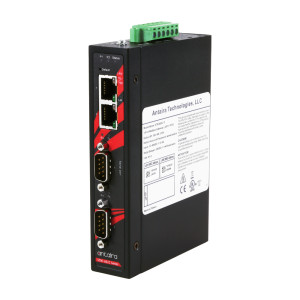Your shopping cart is empty!
MENU

Many businesses have substantial investments in machinery that cannot connect to a LAN or WAN. Communication for older manufacturing and automation equipment was built with serial ports. Protocols like RS-232, RS-422, and RS-485 let devices send and receive data through this port but don't support network access. That prevents data acquisition, fault reporting and diagnosis, or control from remote locations. A replacement may appear to be the only solution. But, there is a far less expensive option: a serial to Ethernet converter (sometimes known as a serial device server).
With Ethernet fast becoming the de facto industrial network standard, it's hard to connect older serial-based equipment. Serial-to-Ethernet converters are the solution. A serial-to-Ethernet converter accepts serial data transmitted at low speed and rebroadcasts it in packetized form over Ethernet. It lets a computer, meter, or PLC without an Ethernet port receive test and measurement data. Thus, serial data can be transmitted over any standard Ethernet network. With full duplex bi-directional capabilities, the reverse is also true. A networked machine or PLC can send signals to the serial device at the appropriate rate. This could open a valve or gate, initiate a process, or perform any of the other myriad tasks needed in a modern industrial setting.
The minimum feature set includes a nine-pin DB9 connector that accepts a serial cable, an RJ45 socket for Ethernet, and firmware to handle the data format conversion. The in-built firmware, which gives the device server a configurable IP address, must be easy to set up and use and capable of updates if needed. It also ensures the device software is independent of the employed operating system or any proprietary protocols. All work with RS-232, RS-422, and RS-485 and provide multiple configuration methods such as a built-in web server, Telnet, serial console, or a Windows-based utility. For long life and high reliability, look for a rugged metal enclosure, broad DC power input range, wide operating temperature, and ESD protection. DIN-rail mounting brackets simplify installation and are either standard or available as a kit, depending on the model purchased.
Serial-to-Ethernet converters are available in a variety of port counts and configurations to serve an extensive set of applications. The STE-501C industrial device server provides single Ethernet and serial ports, allowing for network connection of a single device. The STE-502C has two serial ports. The STE-6104C-T has four serial and two Ethernet ports. Doubling-up on Ethernet ports enables daisy-chaining or provides for redundant network connections. Baud rates are adjustable to suit the connected equipment, and the embedded firmware is upgradeable from the field. These converters accept the nine-pin D-sub or DB-9 connector.
With the durability of old industrial equipment, serial-to-Ethernet converters are one of the best upgrades. Ethernet connectivity is taken for granted in the latest generations of equipment but may be absent in older hardware. That prevents users from reaping the benefits of remote access to retrieve and share test and process data. When legacy equipment includes a serial port offering bi-directional communication over RS-232, RS-422 or RS-485, linking a port to a device server lets this equipment go on a network. With a unique IP address, it enables access from any number of locations.
Westward Sales offers rugged serial-to-Ethernet device servers that connect RS-232, RS-485, and RS-422 equipment to modern IP networks. These units support TCP/IP, virtual COM ports, and secure remote access for SCADA, automation, and industrial control systems. Housing options include DIN-rail mounting, redundant power inputs, and extended temperature operation.
Contact a Westward Sales specialist to select the serial-to-Ethernet solution that fits your deployment, contact your networking specialists at Westward Sales.